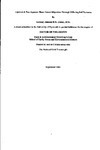Aqueous & Non-Aqueous Phase Tracer Migration Through Differing Soil Textures
| dc.contributor.author | Johnson, Anthony | |
| dc.contributor.other | Faculty of Science and Engineering | en_US |
| dc.date.accessioned | 2013-10-18T09:12:40Z | |
| dc.date.available | 2013-10-18T09:12:40Z | |
| dc.date.issued | 2004 | |
| dc.identifier | NOT AVAILABLE | en_US |
| dc.identifier.uri | http://hdl.handle.net/10026.1/2212 | |
| dc.description.abstract |
The National Grid Transco Company sponsored this project in order to promote the understanding of NAPL migration through b-horizon soils and retarding effects upon non aqueous species migration. Soil structure and texture was also studied using conservative (Bromide) and non-conservative (Phosphate) tracers. Experimental data was produced using a laboratory ½ metre scale automated lysimeter designed and constn1cted at Plymouth. The tracers were compared before oil injection, to calibrate differences in soil texture, and after oil injection to detect any changes in the flow patterns caused by the oil injection. It was found that the Crediton, Sollom and Conway soils respectively offered least resistance to the tracers with the non-conservative tracer behaving much more unpredictably than the conservative tracer. After oil injection it could be seen that the oil had heavily retarded the ability of the tracers to migrate from the injection site. This retardation was identified as analogous to perturbations of the soil structure. Statistical analysis of the data showed that the experiments were all internally self consistent and visible patterns could be seen in the corrected data caused by inclusion of oil in the injection site. Methods of dispersal for the oil and tracer are suggested in the concluding chapter with references to the work of previous authors. Development of a hazard assessment framework was facilitated by the simulation of soil structures using a pedo transfer function developed at the National Soils Resource Institute. To allow the modelling of soils the Pore-Cor software had an annealed simplex algorithm integrated into the data inversion engine to allow the simulation of 3-D soil structures using 2-D data from pedo transfer functions or experimentally derived water retention curves. An extensive sensitivity analysis upon the model highlighted limitations, due to the data set the current pedo transfer function is based upon. It was suggested that inclusion of choices of different pedo transfer functions could be used to overcome this problem. A suitable framework was derived for the identification of priority soils using a validated computer model. Experimental data was compared to the simulated data in order to try and develop an understanding of practical upscaling of the data. The use of the "Scaleway" method is discussed in the concluding Chapter. | en_US |
| dc.description.sponsorship | Tbe National Grid Transco plc | en_US |
| dc.language.iso | en | en_US |
| dc.publisher | University of Plymouth | en_US |
| dc.title | Aqueous & Non-Aqueous Phase Tracer Migration Through Differing Soil Textures | en_US |
| dc.type | Thesis | |
| dc.identifier.doi | http://dx.doi.org/10.24382/3542 |
Files in this item
This item appears in the following Collection(s)
-
01 Research Theses Main Collection
Research Theses Main


